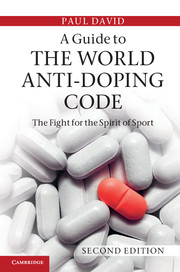Book contents
- Frontmatter
- Contents
- List of Figures
- Preface to the Second Edition
- Table of Cases
- Introduction
- 1 The development of principles relating to anti-doping regimes: the role of the Court of Arbitration for Sport
- 2 Overview of the Code and the World Anti-Doping Program
- 3 The International Standards in more detail
- 4 The nature of the Code and its interpretation and application
- 5 Articles 1 and 2 of the Code: anti-doping rule violations under the Code
- 6 Article 3 of the Code: the proof of anti-doping rule violations under the Code
- 7 Responsibility for testing and investigations, results management and hearings
- 8 Articles 9 and 10 of the Code: sanctions for anti-doping rule violations
- 9 Article 13: appeals under the Code
- 10 Appeals to the Swiss Supreme Court from CAS, challenges to the Code in the courts and claims outside the Code
- 11 The way ahead: review of the 2009 Code
- Index
5 - Articles 1 and 2 of the Code: anti-doping rule violations under the Code
Published online by Cambridge University Press: 05 February 2013
- Frontmatter
- Contents
- List of Figures
- Preface to the Second Edition
- Table of Cases
- Introduction
- 1 The development of principles relating to anti-doping regimes: the role of the Court of Arbitration for Sport
- 2 Overview of the Code and the World Anti-Doping Program
- 3 The International Standards in more detail
- 4 The nature of the Code and its interpretation and application
- 5 Articles 1 and 2 of the Code: anti-doping rule violations under the Code
- 6 Article 3 of the Code: the proof of anti-doping rule violations under the Code
- 7 Responsibility for testing and investigations, results management and hearings
- 8 Articles 9 and 10 of the Code: sanctions for anti-doping rule violations
- 9 Article 13: appeals under the Code
- 10 Appeals to the Swiss Supreme Court from CAS, challenges to the Code in the courts and claims outside the Code
- 11 The way ahead: review of the 2009 Code
- Index
Summary
Article 2 is a central provision of the Code which Signatories must implement without significant amendment. The Article will generally be reproduced verbatim in all Code-compliant doping policies and sets out the violations which may be committed by athletes and other persons who are bound by the Code, and which anti-doping organisations will seek to investigate and establish before tribunals.
Doping is defined by Article 1 as the occurrence of one or more of the anti-doping rule violations in Article 2.1. While collectively defined as doping by Article 1, the violations in Article 2 extend beyond the violations of doping (in the sense of having an athlete having a prohibited substance or its metabolites or markers in his or her bodily sample or using a prohibited method) and refusing to submit to testing, which have largely been the focus of anti-doping investigations and proceedings to date, and include violations which involve various forms of intentional conduct relating to prohibited substances or the testing process. This general range of violations was present in the OMADC, and in many sports anti-doping policies before the Code, but the enforcement of anti-doping regimes focused, to a considerable degree, on the detection of the presence of Prohibited Substances and Methods by collecting and analysing bodily samples for testing.
- Type
- Chapter
- Information
- A Guide to the World Anti-Doping CodeA Fight for the Spirit of Sport, pp. 130 - 200Publisher: Cambridge University PressPrint publication year: 2013

